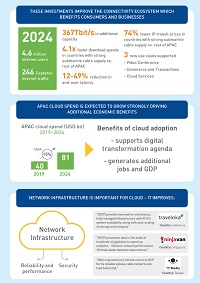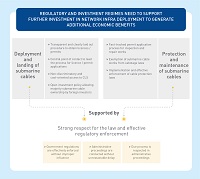Economic impact of Google's APAC network infrastructure
24 September 2020
David Abecassis | Dion Teo | Michael Kende | Prof. Neil Gandal (independent adviser)
Report
The internet is now essential to how consumers, businesses and governments around the world live and work. As more and more people and businesses access the internet, use more services and consume more content, investments are required to improve network infrastructure. This infrastructure provides the critical link from content and services in content, application and service providers’ (CASP) data centres, to customers and end users on internet service providers’ (ISP) networks. Network infrastructure also underpins the reliable and secure cloud services that are essential for digital transformation. These cloud customers have access to capabilities that most of them would otherwise not be able to build by themselves.
In response to increasing demand for online content and services, including cloud services, Google has made significant investments in network infrastructure globally. In Asia–Pacific (APAC), Google has invested over USD2 billion since 2010. It purchases two thirds of its international bandwidth in the region from APAC carriers, and is an investor in six already-deployed submarine cable systems. In addition, Google has deployed points of presence in 15 cities across 8 economies, and Google Global Cache (GGC) nodes in 278. To connect these points of presence, data centres and submarine cable landing stations (CLS), Google leases capacity on domestic fibre networks.
These investments create positive impacts on the connectivity ecosystem across APAC: higher bandwidth, lower latency, greater number of people online. This, in turn, creates remarkable economic impact, both directly in the telecoms sector and as a ‘spill-over’ in other sectors of the economy. The econometric models we developed for this study suggest that Google’s network investment led to 1.1 million additional jobs as of 2019 and an extra USD430 billion in aggregate GDP for the region between 2010 to 2019 (in real 2019 USD).
Google’s network infrastructure also serves as the underlying infrastructure delivering cloud traffic. The investments provide additional route diversity, connecting cloud regions in APAC with each other and to other regions through different paths. They also enable low service latency and high levels of availability of cloud services. Lastly, carrying cloud traffic on Google’s own infrastructure increases security of cloud services, making traffic less likely to be attacked, intercepted or manipulated by malicious actors.
In anticipation of future growth in data traffic, Google will continue to make investments in new submarine cables, such as the PLCN, Indigo and JGA-S systems, and further densify the edge network infrastructure across APAC cities. These future investments will continue to deliver economic benefits of around 1.8 million additional jobs and USD415 billion in GDP (real 2019 USD) over the next 5 years (2020–2024).
While there has been increasing investment in this area, more can be done to make the environment more conducive to further investment. Economies with strong submarine cable supply typically have conducive regulatory and investment policies, supported by transparent and well-enforced laws: they provide best practices on how other economies, in the region and elsewhere in the world, can attract more investment in internet infrastructure.
We collaborated on this report with Prof. Neil Gandal from Tel Aviv University.
Infographics:
Authors

David Abecassis
Managing Partner, expert in strategy, regulation and policy
Dion Teo
Partner, expert in strategy



